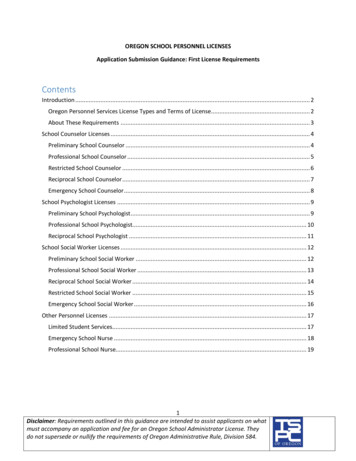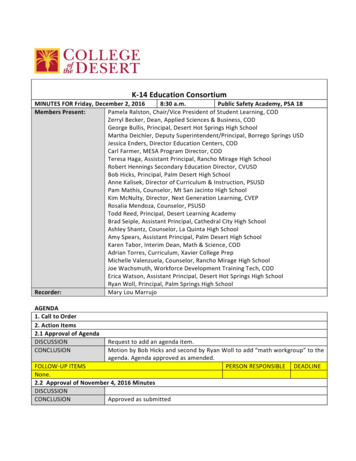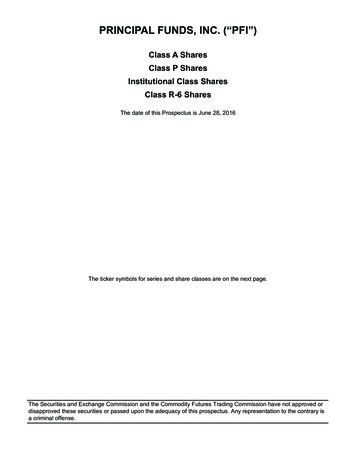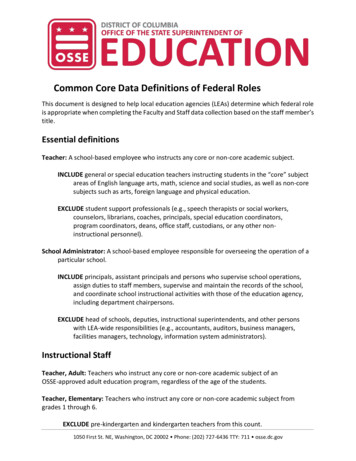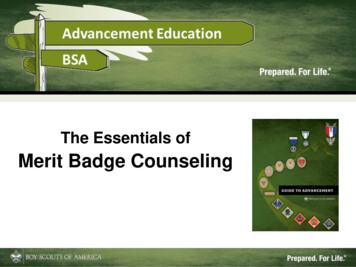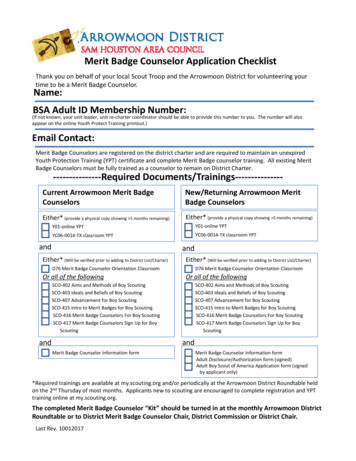
Transcription
EnhancingThe Principal–SchoolCounselor Relationship:A ToolkitCOLLABORATING FOR EQUITY AND STUDENT OUTCOMES
About College BoardCollege Board is a mission-driven not-for-profit organization that connects students tocollege success and opportunity. Founded in 1900, College Board was created to expandaccess to higher education. Today, the membership association is made up of over 6,000 ofthe world’s leading educational institutions and is dedicated to promoting excellence andequity in education. Each year, College Board helps more than seven million students preparefor a successful transition to college through programs and services in college readiness andcollege success—including the SAT , the Advanced Placement Program, and BigFuture .The organization also serves the education community through research and advocacy onbehalf of students, educators, and schools.For further information, visit collegeboard.org.
Contents5Welcome Message and Orientation to the Toolkit7Toolkit Sequencing Options6Using the Toolkit8A Unifying Purpose: Equity as Bedrock81113A Primer in EquityProfessional Competencies and Commitments to EquityEquity in Action: Reflection Questions14Articulating Purpose, Vision, and Mission16Aligning Vision and Advancing Mission14Sharing Purpose18Exploring Opportunities for Alignment and Collaboration19Reflecting on Personal Development and Goals21Effective Communication24Aspects of Effective Communication23Self-Assessment: Effective Communication26Effective Communication: The Art of Connecting273031323334353738Communication Structures: Sample Recurring Meeting TemplatesFostering AgreementStrategies for Communicating ChangeCommitment to a Culture of InquiryProviding FeedbackEffective Communication for ConflictStrategies for Facilitating Difficult ConversationsStrategies for Addressing Team ConflictStrategies for Effective Communication in Moments of Crisis40Ensuring Equity: Assessing Context and Capacity44Equity: Our Work in Our Schools40Understanding Our School Context: Awareness, Reflections, and Actions46Assessing Data and Investigating Inequities535657Engaging Your CommunityAssessing the Strengths and Needs of At-Risk StudentsSummer Equity and Strategy Data Walks58Cultivating Trust and Respect65Nonnegotiables for the Principal-School Counselor Relationship58Relationship Self-Assessment67Actions, Interactions, Behaviors, and Beliefs: Assessing Trust and Respect6972Building Trust: Team ChecklistDefining Trust in the Context of Our School
75Sustaining Trust: Clarifying Expectations and Supporting Performance78Leadership, Part I: Collaborating and Sharing Decision Making79Five Approaches to Leadership76Self-Reflection: When Trust Is Challenged78Leadership Approaches: Advancing Collaboration and Shared Decision Making83School-Based Leadership Team (SLT)84Considerations for School Counselor Leadership: Five Essential Characteristics85Leadership, Part II: Advancing Student Achievement87Leadership and Student Achievement85Collaborative Leadership Self-Assessment: Shared Responsibility for Student Success88Establishing a Culture of Inquiry: School Counselors as Thought Partners for the Academic Program8990929495Culture of InquiryEstablishing a Culture of Inquiry: Essential Norms and ExpectationsAnnouncing a Culture of Inquiry ExperiencePrincipal-School Counselor Strategic Planning ToolSchool Counselor Leadership Planning Worksheet96Supporting a New Principal or New School Counselor97Advanced Strategies for the New Leader: Principals and School Counselors96Transition Traps99Successful Leadership Transitions: Onboarding Essentials100 Onboarding Action Plan100 Five Conversations for New Leaders102 Five Conversations Action Plan104 Continuous Improvement and Advanced Practices104 Job Shadowing105 Shared Professional Development Experiences106 Reporting Outcomes to Families and Stakeholders
Welcome Message andOrientation to the ToolkitTo all Principals and School Counselors,The world of education is more challenging than ever, and the success of a school depends onthe educators leading the school. In addition to teachers, principals and school counselors provideenergy to guide student learning and growth. When principals and school counselors worktogether for positive change in a school, amazing things happen.This principal–school counselor toolkit represents a collaborative resource that acknowledgesand celebrates the influence of the collaboration of principals and school counselors in schoolcommunities. This resource elevates promising practices refreshed from the previous edition andadds findings from stakeholder surveys, interviews, and focus groups, and the rich contributionsof the American School Counselor Association (ASCA) and the National Association of SecondarySchool Principals (NASSP).We continue to learn what principals and school counselors describe as important in theirrelationships and how they view the current status of these relationships. Informed by thesedata points and reflections, this toolkit includes reflective exercises, templates, strategies,and protocols for navigating unique challenges and opportunities within the principal–schoolcounselor relationship.Throughout this toolkit, you’ll find resources to help guide discussions, self-appraisals, reflections,and implementation of strategy. This toolkit will also help you plan for the arrival of a new leader and/or a new counselor, the start of a new academic year or term, creating a school-based leadershipteam, and more. Wherever appropriate, make adjustments to these resources to ensure they aresuited to your needs and the context relevant for your school community.We know that schools aren’t one-size-fits-all, and the people who lead schools sometimes holddifferent titles and fill various roles. Throughout the toolkit, we use the title “principal” to refer tothe leader of the school. In some cases this person is an executive director, head of school, siteleader, or CEO. For the purpose of this toolkit, we refer to the school leader as principal, knowingthat some won’t share this title, but will share the ultimate responsibility for managing theleadership of a school.Likewise, not all who counsel students are school counselors. Some have responsibilities as careercounselors, others are college counselors, while still others are academic counselors. No matteryour title, we hope you’ll see some of your roles and responsibilities represented in this toolkit anduse it in a way that improves your work in schools.Thank you for all you do in support of students.Lorraine HastingsVice President, Counselor Community EngagementCollege BoardWelcome Message and Orientation to the Toolkit5
Using the ToolkitPrincipals and school counselors are encouraged to use this resource as a tool forcontinuous engagement and relationship development. To begin, we acknowledgethe importance of vision and mission in any organization, providing a guiding light forall work within the school community. The Articulating Purpose, Vision, and Missionsection defines the shared purpose in principal–school counselor relationships and howthis shared purpose aligns with the vision and mission for the school as a whole, and theschool counseling program in particular.In the next section, Effective Communication, you’ll find tools and exercises to helpdefine your communication style and preference, communicate during transitions, andaddress conflict among individuals and teams.In the Ensuring Equity section, principals and school counselors are guided throughpractices and discussion questions that will help assess equitable practices and areasfor growth within the school community. This section includes a discussion of essentialdata points, how to disaggregate data for the various communities represented withinthe school, and explains how data should inform interventions and decisions.The Cultivating Trust and Respect section identifies key practices to ensure alignment,understanding, and agreement among principals and school counselors. It includes anumber of exercises and protocols to guide discussions, inform practices, and supportnecessary interventions as needed.Leadership is separated into two distinct content areas, with the first focusing onCollaborating and Sharing Decision Making. Principals and school counselorsare encouraged to reflect on their structures and practices and how they approachleadership together. Leadership is further examined in Advancing StudentAchievement. As an extension of the equity dialogue, this section offers practices toengage school counselors in leadership for the academic experience for students.Advancing a culture of inquiry to best understand instruction and advance studentachievement is enhanced through the lens of equity.This toolkit closes with resources and discussions of Supporting a New Principal orNew School Counselor and Continuing Improvement and Advanced Practices. Asindividuals and in pairs, you can use these resources to help ensure success in uniquesituations, as well as while onboarding new principals and counselors into the community.6Welcome Message and Orientation to the Toolkit
Toolkit Sequencing OptionsThis toolkit is an adaptive resource that you can revisit as you face new opportunitiesand challenges in your work. Although not prescriptive, you may want to choose one ofthe following sequences depending on your school community needs:If your school has a new principal/new school counselor:Supportingthe NewLeader/theNewCounselorEquity asBedrockArticulatingPurpose,Vision, andMissionEnsuringEquityIf you are concerned with opening/closing the academic year (annual data focus):Equity asBedrockEnsuringEquityLeadership II:AdvancingStudentAchievementLeadership I:Collaboratingand SharingDecisionMakingIf your focus is opening/closing the academic year (annual relationship focus):Equity asBedrockArticulatingPurpose,Vision, andMissionE ectiveCommunciationCultivatingTrust andRespectIf you are working together as veteran school counselors and veteran leaders:EnsuringEquityLeadership II:AdvancingStudentAchievementLeadership I:Collaboratingand SharingDecisionMakingContinuousImprovementand AdvancedPracticesIf you’re interested in promoting counselors as leaders:Supportingthe NewLeader/NewCounselorArticulatingPurpose,Vision, andMissionEnsuringEquityLeadership II:AdvancingStudentAchievementWelcome Message and Orientation to the Toolkit7
A Unifying Purpose: Equityas BedrockIt is through a shared and fundamental commitment to equity that all other facets of the principals andschool counselors’ work can be established and built.As you engage with this toolkit, consider the words of Vincena Allen, Chief Growth Officer of The SEEDFoundation: “All that we are doing—how we lead, how we operate, how we inspire—is in service to equityfor all of our students and their families, and their dreams.”A Primer in EquityEquity as bedrock requires principals and school counselors to begin by defining anddistinguishing your perspectives on equity and equality. In the space below, reflect onthe similarities and differences between equity and equality, and how these conceptsare defined in your community. Consider the things you do within your practice thatelevate equality and the barriers and obstacles you remove to ensure equity.Reflection: What is your definition of equity?Reflection: What is your definition of equality?Reflection: What needs to be removed to ensure equity?Reflection: What is elevated to ensure equality?The Center for Public Education suggests that “equality in education is achieved whenstudents are all treated the same and have access to similar resources” (Barth 2016, 1).The National Association of Secondary School Principals (NASSP) concept of anequitable educational environment begins with ensuring equality. The school communityis one which “supports and develops each student, regardless of his or her race, gender,sexual orientation, disability, or socioeconomic standing” by providing equal “accessto strong learning opportunities and high expectations.” NASSP also stresses theimportance of providing the adults in a school community “an environment that valuesthem as people and treats them fairly, regardless of their background,” in part through“a commitment to social justice, civil rights, and human connectedness” (2018, 68).8A Unifying Purpose: Equity as Bedrock
Further, as an integral part of the school community, school counselors develop andimplement school counseling programs that promote equity and access for students,helping to close achievement, opportunity, attainment and funding gaps in their schools,districts, and communities, according to the American School Counselor Association (2018).In its Building Ranks framework of school leadership, the National Association ofSecondary School Principals (NASSP) reminds us that “school leaders guarantee thateach person is known, valued, and treated justly and receives the individualized, highquality education that is necessary to succeed in a global society” (NASSP 2018, 68).In defining equity, NASSP suggests that equity is “the behaviors, systems, processes,resources, and environments that ensure that each member of the school community isprovided fair, just, and individualized learning and growth opportunities” (2018, 68).ASCA’s Ethical Standards state that all students from all backgrounds have the rightto be respected and treated with dignity, and to have access to a school counselingprogram that advocates for and affirms them. As social justice advocates, schoolcounselors support students from all backgrounds and circumstances.Likewise, College Board is committed to and inspires educators to ensure equity whenit comes to access to challenging, college-level coursework in high school. CollegeBoard strongly encourages educators to make equitable access a guiding principle bygiving all willing and academically prepared students the opportunity to participate inchallenging coursework. We encourage the elimination of barriers that restrict access tochallenging coursework for students from ethnic, racial, and socioeconomic groups thathave been traditionally underrepresented. Schools should make every effort to ensurethat their most challenging classes reflect the diversity of their student population. It’sonly through a commitment to equitable preparation and access that true equity andexcellence can be achieved.The Achievement Network (2018) offers a definition of equity that the American SchoolCounselor Association (ASCA) emphasizes within the ASCA National Model: “Educationalequity occurs when educators provide all students with the high-quality instructionand support they need to reach and exceed a common standard.” The AchievementNetwork, Ltd. provides further context for defining equity:“Equity focuses on outcomes for students. Equity in education demandsthat we hold the same high expectations for all students, regardless of theirgender, race, ethnicity, and socioeconomic background. It requires leadership,practices, and school culture that guarantee educators help all students meetthose expectations. The work of educators is not to lower the bar; it’s toprovide all students with the support they need to reach and exceed the bar sothey’re prepared for college, career, or life” (Achievement Network 2018).A Unifying Purpose: Equity as Bedrock9
Within Building Ranks, NASSP offers four strategies that school leaders can implementto advance equity throughout the school community:1. Ensuring that each student is known and valued;2. Diagnosing inequitable practices or structures;3. Inspiring staff members, students, and parents to understand and resolve issuesof equity;4. Leading members of your learning community in identifying and implementingstrategies that promote equity, including culturally responsive teaching and learning(NASSP 2018, 69).Lastly, Building Ranks underscores three imperatives for a commitment to equity inour schools:1. Foundations of equity should be found within vision and mission statements;2. Evidence of equity should be present in the school’s approach to learning—student-centered and ethical practices;3. Foundations of equity should be evident in the expectations informing instructionalpractices and desired student achievement outcomes (NASSP 2018).ASCA National Model addresses this commitment to equity as well.1. Equity, access, and success for every student is a key component of the missionof a school counseling program. School counselors promote equity through theimplementation of a comprehensive school counseling program,2. School counselors use data to demonstrate a need for systemic change inareas such as course enrollment patterns; equity and access; and achievement,opportunity, and/or information gaps.3. School counselors provide direct students services to help all students becomecollege and career ready, and provide indirect student services of collaboration,consultation, and referrals, school counselors enhance student achievement andpromote equity and access for all students.4. School counselors create systemic change through the implementation of acomprehensive school counseling program.5. School counselors partner with others to advocate for student achievement andeducational equity and opportunities.6. School counselors promote equity and access for all students through the use ofcommunity resources.10A Unifying Purpose: Equity as Bedrock
Professional Competencies and Commitmentsto EquityThe National Policy Board for Educational Administration (NPBEA), in its ProfessionalStandards for Educational Leaders, defines expectations for effective leadership in thearea of equity and cultural responsiveness. Within Standard 3, “effective educationalleaders strive for equity of educational opportunity and culturally responsive practicesto promote each student’s academic success and well-being” (NPBEA 2015, 11).This standard also details the following for effective leaders:a.Ensure that each student is treated fairly, respectfully, and with an understanding of each student’sculture and context.b.Recognize, respect, and employ each student’s strengths, diversity, and culture as assets for teachingand learning.c.Ensure that each student has equitable access to effective teachers, learning opportunities, academicand social support, and other resources necessary for success.d.Develop student policies and address student misconduct in a positive, fair, and unbiased manner.e.Confront and alter institutional biases of student marginalization, deficit-based schooling, and low expectationsassociated with race, class, culture and language, gender and sexual orientation, and disability or special status.f.Promote the preparation of students to live productively in and contribute to the diverse cultural contextsof a global society.g.Act with cultural competence and responsiveness in their interactions, decision making, and practice.h.Address matters of equity and cultural responsiveness in all aspects of leadership.(NPBEA 2015, 11)For the complete description of the Professional Standards for Educational Leaders,visit: Standards-forEducational-Leaders 2015.pdf.The ASCA National Model defines professional standards and competencies in bothmindsets (“beliefs school counselors hold about student achievement and success”)and behaviors (“essential behaviors school counselors demonstrate through theimplementation of a comprehensive school counseling program”) (ASCA 2019a, 6).The ASCA School Counselor Professional Standards & Competencies articulates thefollowing mindsets to be held by school counselors:M 1.Every student can learn, and every student can succeed.M 2.Every student should have access to and opportunity for a high-quality education.M 3.Every student should graduate from high school prepared for postsecondary opportunities.M 4.Every student should have access to a comprehensive school counseling program.M 5.Effective school counseling is a collaborative process involving school counselors, students, families,teachers, administrators, other school staff, and education stakeholders.M 6.School counselors are leaders in the school, district, state, and nation.M 7.Comprehensive school counseling programs promote and enhancestudent academic, career, and social/emotional outcomes.(ASCA 2019a, 6)A Unifying Purpose: Equity as Bedrock 11
A focus on equity can also be found in various behaviors defined within the ASCA SchoolCounselor Professional Standards & Competencies:B-PF 6.Demonstrate understanding of the impact of cultural, social, and environmental influences on studentsuccess and opportunities.B-PF 8.Demonstrate advocacy in a comprehensive school counseling program.B-PF 9.Create systemic change through the implementation of a comprehensive school counseling program.B-SS 4.Make referrals to appropriate school and community resources.B-SS 5.Consult to support student achievement and success.B-SS 6.Collaborate with families, teachers, administrators, other school staff, andeducation stakeholders for student achievement and success.B-PE 2.Identify gaps in achievement, attendance, discipline, opportunity, and resources.B-PE 3.Develop annual student outcome goals based on student data.B-PE 4.Develop and implement action plans aligned with program goals and student data.(ASCA 2019a, 7)These behaviors highlight essential considerations and actions for ensuring equitywithin our schools. For the complete description of the ASCA School CounselorProfessional Standards & Competencies, visit 65-a3235f3b93c3/SC-Competencies.pdf.12A Unifying Purpose: Equity as Bedrock
Equity in Action: Reflection QuestionsThe theme of Equity as Bedrock relies on reflection, critical dialogue, and discussionregarding practice and leadership. Use the following prompts for self-reflection anddiscussion within your school counseling department and/or your school leadershipteam (SLT).Reflection QuestionsSelf-ReflectionWhat questions should we be asking ourselves aswe work to ensure equity in our school communityand equitable outcomes for our students?How might we assess equity in our work andour intentions?How are we assessing our own biases and assumptions?a. What are the biases and assumptions that I mayhold regarding students and/or student groups?b. How might these biases and assumptions inhibit,deter, and/or prevent me from providing equitableresources, supports, and/or treatments to students?c. What will I need to do differently to ensure that thesebiases and assumptions don’t impact my work,especially how I serve students and their families?If we were to focus on ensuring the success ofstudents with the greatest need, and/or those whoexperience the greatest marginalization within ourschool communities, how might our efforts or policieschange? How might we learn from providing equitableexperiences for the students with the greatest needto inform our practices throughout our community?How might equity be embedded within one’sprofessional identity?How might equity be articulated asa professional expectation?A Unifying Purpose: Equity as Bedrock 13
Articulating Purpose,Vision, and MissionSimon Sinek et al. (2017) discusses the importance of exploring your “why?” and how your purpose isdefined, informed, and experienced by others. The exploration of “why?” launches deep into assessing yourunderstanding of your own purpose, power, and the driving force behind your work. This same question of“What’s your why?” is essential to describe your personal purpose and its connection to the purpose, vision,and mission of your school community.This section of the toolkit encourages you to reflect on your personal purpose and how that informs yourwork. Then, you will assess and describe the alignment of your purpose and how it can foster even greatercollaboration and leadership within the principal–school counselor relationship.The commitment to equity is a shared priority and is best stated clearly in your school’s mission andvision, and your school counseling vision and mission. Tools in this section can help you articulate yourcommitment to equity and offer opportunities for frequent review and reflection.Sharing PurposeConsider the following reflection questions as the foundation for developing a personalpurpose statement in service of student learning and growth. This purpose statementwill encapsulate your personal and professional aims and help clarify cooperativeopportunities in the principal–school counselor relationship.Reflection QuestionsWho am I? What do I wish to be rememberedfor? What’s my desired legacy?How do I wish for others to describe me? How doI wish for others to describe my work? What willoccur as a result of my professional contributions?Who am I as a professional? What is most importantto me as I do this work?What do I need most to be successfulin this role? What do I need most to besuccessful in this role, this year?14Articulating Purpose, Vision, and MissionSelf-Reflection
Draft a personal statement of purpose. Describe who you are, how you wish to beremembered, what you need to be successful, and how you will know your purpose hasbeen achieved.From your purpose statement, create a headline or mantra by selecting three to fivewords that represent the essence of your purpose and professional impact.Purpose Statement:Headline/Mantra(3–5 words)Share your purpose statement and headline/mantra with your principal or schoolcounselor partner. In the space below, record their purpose statement andheadline/mantra.Purpose Statement:Headline/Mantra(3–5 words)Identify the common themes or shared ideas.Themes from PrincipalThemes from School CounselorArticulating Purpose, Vision, and Mission 15
Draft a Shared Purpose Statement. This statement should represent shared perspectivesthat capture the ideas and agreements in your personal purpose statements. From thisshared statement, define a headline or mantra. You are encouraged to use both yourshared purpose statement and mantra as touchpoints in later sections of the toolkit.Principal–SchoolCounselor SharedPurpose StatementPrincipal–SchoolCounselor SharedMantra (3–5 words)Aligning Vision and Advancing MissionTo create a school environment that prioritizes student achievement, as schoolprofessionals you must align the following areas:§ What we believe (purpose)§ What we want the results to look like (vision)§ How we are going to get there (mission)With your shared purpose statement and mantra to guide you, you can better envision theresults you want for your students, and how the school community can organize to get there.In Building Ranks (2018, 132). NASSP identifies creating a shared vision and mission—”clear and ambitious expectations for what will benefit students and what they willbe able to do as a result of attending the school”—as an essential element of schoolleadership. A shared understanding of vision and mission “enables the entire communityto have a shared commitment to achieving those goals and helps leaders set prioritiesand make decisions aligned with its goals.”Similarly, the ASCA National Model includes a process of examining and reflecting onpersonal, school, and district beliefs about all students, analyzing the school’s vision andmission, and aligning the school counseling program vision and mission with the schoolvision and mission.The vision describes what school counselors hope to see for students 5–15 years in thefuture. The mission aligns with the school’s mission statement and emphasizes equity,access, and success for every student.16Articulating Purpose, Vision, and Mission
What is the vision of our school community?What is the mission of our school community?How does the work of the principal advancethe vision and mission of the school?How does the work of the school counseloradvance the vision and mission of the school?How does the mission ensure equity,access, success, and long-term resultsfor all students? If there are neededrevisions to these statements to ensureequity, what do you feel is missing?Articulating Purpose, Vision, and Mission 17
Exploring Opportunities for Alignmentand CollaborationIn the Equity as Bedrock section, the professional competencies for principals andschool counselors were highlighted to show alignment to equity.Use the following questions to reflect on possibilities for alignment, collaborativeleadership, engagement, and support for the success of the principal–school counselorrelationship. As you focus on your school community, consider the opportunities forleadership and growth that can emerge from empowering staff to be stewards of theschool’s vision and mission.Where are there collaborativeopportunities among principalsand school counselors interms of our professionalcompetencies and expectations?Where are there differentiationin roles and expectations?Where are there opportunities forshared leadership? Where can wehelp each other achieve our goals?What are the opportunitiesfor delegation (distributedleadership)? How can we helpeach other execute the work?From these professionalexpectations, where should wespend time building systemsand/or structures to ensurethe success of our efforts?From these professionalexpectations, where should wespend time clarifying and ensuringshared understanding in our work?What isn’t captured in thesecompetencies that is worth drawingattention to, especially itemsspecific to our school community?18Articulating Purpose, Vision, and Mission
Reflecting on Personal Development and GoalsNow that you have assessed your personal and shared statements of purpose and howthey align to the school community, take a deeper look at how these statements informyour vision for yourself and your growth. Complete the following self-assessment toarticulate career goals, areas of growth and strength, and de
To all Principals and School Counselors, The world of education is more challenging than ever, and the success of a school depends on the educators leading the school. In addition to teachers, principals and school counselors provide energy to guide student learning and growth. When principals and school counselors work


